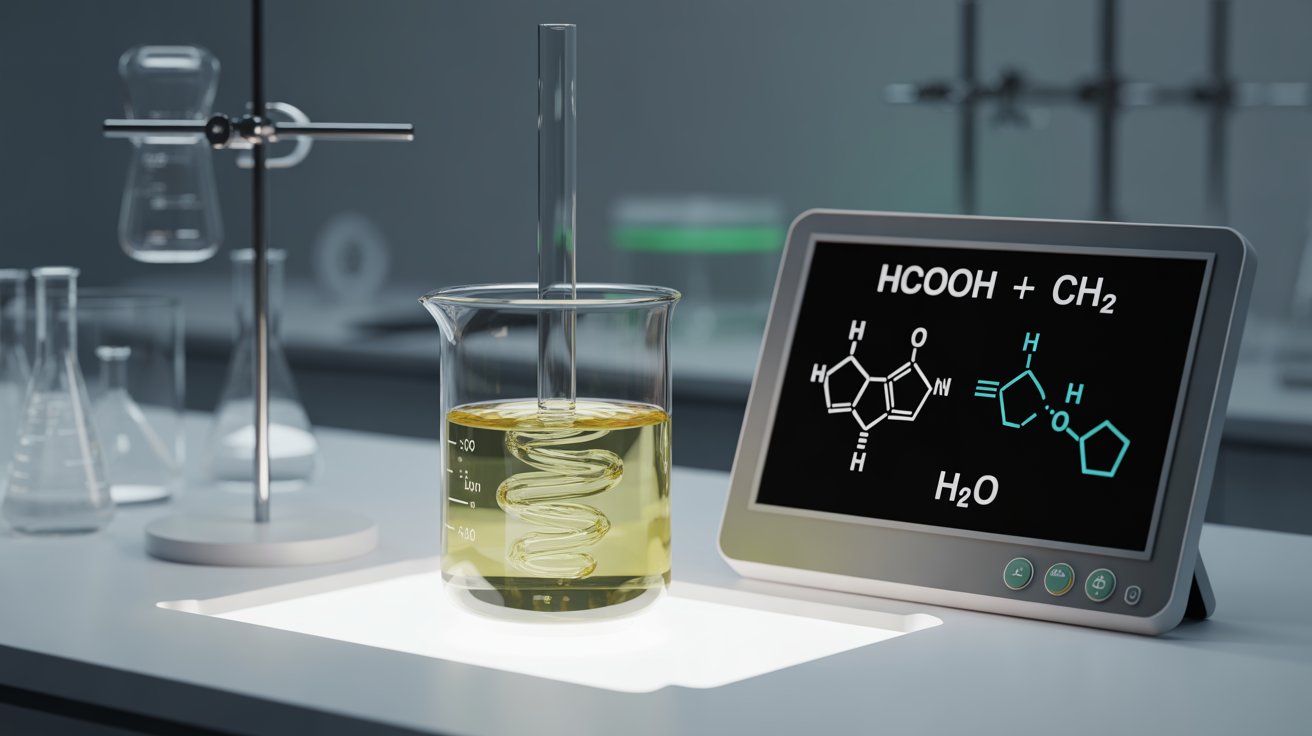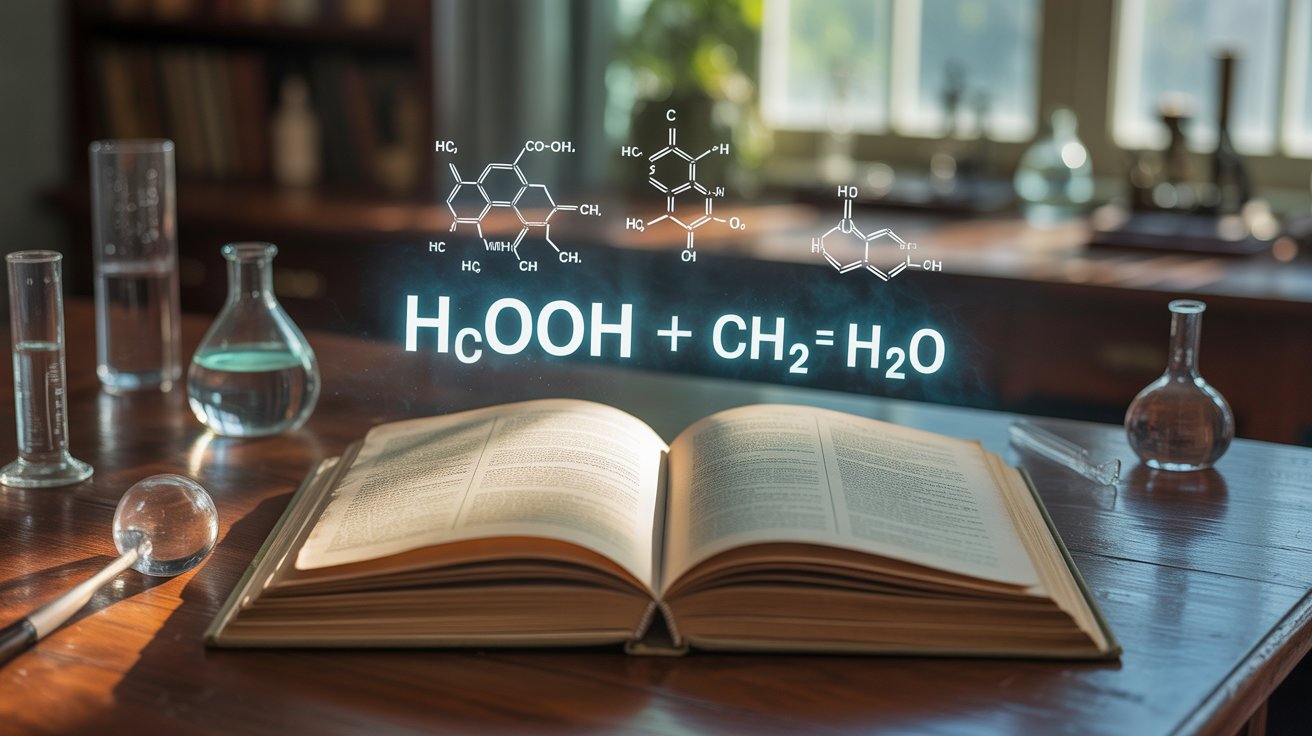Science
Understanding HCOOH + CH₂ → H₂O: A Complete Guide

Chemical reactions involving formic acid (HCOOH), methane derivatives (CH₂), and water (H₂O) are of great importance in organic and inorganic chemistry. This combination represents not only a fascinating aspect of chemical bonding but also plays a significant role in industrial applications, energy conversion, and environmental chemistry. In this article, we will explore the complete reaction mechanism, practical uses, and scientific background of this formula in detail.
What is HCOOH? – The Role of Formic Acid
Hcooch ch2 h2o, or formic acid, is the simplest carboxylic acid. It is a colorless liquid with a pungent odor, naturally found in the stings of ants and bees. Its molecular structure consists of a carboxyl group (–COOH) attached to a single hydrogen atom.
Formic acid is highly reactive and serves as a reducing agent in chemical processes. It is widely used in:
-
Textile industry for dyeing and finishing fabrics.
-
Leather industry for tanning hides.
-
Fuel cells as a potential clean energy source.
-
Preservative and antibacterial agent in livestock feed.
Because of its reactive nature, HCOOH easily combines with other compounds, including hydrocarbons and water molecules.
Understanding CH₂ – The Hydrocarbon Fragment
The notation CH₂ often represents a methylene group, a hydrocarbon fragment found in many organic compounds. It is not typically stable in isolation but forms part of larger molecules such as alkanes, alkenes, and polymers.
The CH₂ group plays a vital role in synthetic chemistry and industrial reactions. It can participate in:
-
Polymerization reactions (forming plastics and synthetic fibers).
-
Combustion processes when combined with oxygen and hydrogen.
-
Energy generation as part of hydrocarbon fuels.
When CH₂ interacts with HCOOH and H₂O, it contributes to reactions that yield stable organic or inorganic products.
The Importance of H₂O – Water as a Product and Solvent
Water (H₂O) is not only the most common product in chemical reactions but also the universal solvent that facilitates these transformations. In reactions involving HCOOH and CH₂, water can appear either as a by-product or as a medium in which the reaction occurs.
Water ensures proper ionization, stabilizes charged intermediates, and regulates the heat of the reaction. Without H₂O, many organic transformations would be impossible to achieve in industrial and laboratory conditions.
Reaction Mechanism of HCOOH + CH₂ → H₂O
The reaction between formic acid (HCOOH) and a methylene group (CH₂) typically leads to the release of water (H₂O). While the exact mechanism depends on conditions such as temperature, pressure, and catalysts, the general process involves:
-
Activation of the carboxyl group in formic acid.
-
Interaction with CH₂ fragments, resulting in intermediate bonds.
-
Elimination of water molecules, stabilizing the final compound.
This process is essential in dehydration reactions and organic synthesis pathways where water elimination is necessary to form double bonds or more complex molecules.

Industrial Applications of HCOOH + CH₂ → H₂O
The combination of HCOOH, CH₂, and H₂O has significant practical applications in various industries:
1. Polymer Production
Formic acid acts as a reactant in producing polyesters, resins, and plastics. The removal of H₂O during polymerization is essential to create strong, durable materials.
2. Fuel Cells and Energy Conversion
In direct formic acid fuel cells (DFAFCs), the controlled release of hydrogen and water plays a key role in producing clean electricity. CH₂-containing fuels enhance energy efficiency.
3. Organic Synthesis
Chemists use HCOOH reactions with hydrocarbons to synthesize aldehydes, alcohols, and esters. Water formation confirms the completion of the reaction.
4. Leather and Textile Treatment
HCOOH and hydrocarbon-based agents are applied in tanning and finishing. The elimination of water ensures better binding of dyes and preservation of fabrics.
5. Environmental Chemistry
These reactions contribute to biodegradation and carbon cycling in nature. They highlight the way natural processes recycle organic compounds into water and carbon dioxide.
Laboratory Insights: Controlled Conditions for HCOOH Reactions
In the laboratory, the reaction between formic acid and hydrocarbon fragments is carefully controlled. Key factors include:
-
Catalysts such as metal oxides or strong acids that accelerate water elimination.
-
Temperature regulation to ensure the reaction proceeds efficiently without decomposition.
-
Pressure conditions when scaling up for industrial use.
-
Solvent choice, with water often acting both as a participant and medium.
These conditions ensure high yields and purity of products, making the reaction reliable for research and industrial manufacturing.
Environmental and Safety Considerations
While the HCOOH + CH₂ → H₂O reaction has numerous benefits, safety measures are essential:
-
Formic acid is corrosive and can cause burns on skin contact. Proper protective gear is mandatory.
-
Ventilation is required in industrial settings to avoid inhalation of harmful vapors.
-
Waste management must prevent chemical discharge into natural water systems, protecting ecosystems.
Sustainable practices such as green chemistry approaches are being developed to minimize risks and optimize energy efficiency.
Future Potential of HCOOH + CH₂ → H₂O Reactions
The growing demand for renewable energy, biodegradable materials, and eco-friendly industrial solutions means that the study of this reaction is more relevant than ever. Scientists are focusing on:
-
Developing catalytic processes that reduce energy consumption.
-
Enhancing the efficiency of formic acid fuel cells.
-
Using CH₂ groups in biopolymer production.
-
Expanding water recycling methods in industrial applications.
The continued exploration of this chemistry ensures its role in the future of sustainable technology.
Conclusion
The chemical interaction represented by hcooch ch2 h2o is far more than a simple reaction. It is a cornerstone of organic chemistry, industrial production, and environmental science. From its role in polymerization and energy generation to its importance in sustainable practices, this process demonstrates how simple molecular interactions can drive global progress. By mastering the mechanisms and applications of this reaction, industries can move closer to efficiency, safety, and sustainability.
FAQs on HCOOH + CH₂ → H₂O
Q1: What is the significance of HCOOH in chemical reactions?
HCOOH, or formic acid, acts as a reducing agent and is widely used in textiles, tanning, and clean energy research.
Q2: How does CH₂ participate in this reaction?
CH₂, as a methylene group, interacts with formic acid to form intermediates that release water, aiding in polymerization and organic synthesis.
Q3: Why is H₂O produced in this reaction?
Water results from dehydration processes that stabilize the final product, making it an essential by-product in chemical synthesis.
Q4: What industries benefit most from this reaction?
Industries such as polymer manufacturing, textiles, energy, and environmental sciences benefit significantly.
Q5: Is this reaction environmentally friendly?
Yes, when managed properly with catalysts and sustainable methods, it supports green chemistry initiatives and renewable energy technologies.

Science
Speciering: The Complete Guide to Understanding, Applications, and Importance

In the world of chemistry, biology, and material sciences, speciering plays a vital role in analyzing, identifying, and classifying different species of elements, compounds, and molecules. The process of speciering provides deeper insights into the structure, properties, and interactions of substances. By understanding speciering, researchers, scientists, and professionals across multiple fields gain the ability to develop innovative solutions, ensure environmental safety, and push forward advancements in medicine, technology, and industry.
In this comprehensive article, we explore what speciering is, its significance, methods, challenges, and applications across different domains.
What is Speciering?
Speciering refers to the detailed identification and classification of chemical species within a sample. This process does not merely detect the presence of an element or compound but determines its specific form, oxidation state, molecular structure, or isotopic composition. For example, distinguishing between chromium (III) and chromium (VI) in a water sample is critical since one is essential for health while the other is toxic.
Through speciering, scientists can move beyond simple detection and uncover how substances behave in real-world conditions, interact with other compounds, and impact health or the environment.
Importance of Speciering in Modern Science
The significance of speciering cannot be overstated. Its applications are widespread and crucial:
-
Environmental Monitoring: Identifying pollutants and understanding their transformations in soil, water, and air.
-
Food Safety: Determining the presence of toxic metals or beneficial micronutrients in different chemical states.
-
Pharmaceuticals: Studying drug composition, stability, and interactions with biological systems.
-
Industrial Processes: Controlling product quality by analyzing raw materials and byproducts.
-
Medical Diagnostics: Tracking biomarkers and metal-based compounds in the human body.
By classifying chemical forms, speciering ensures safety, compliance with regulations, and advancements in technology.
Methods and Techniques Used in Speciering
Different analytical techniques are used in speciering, depending on the sample type and required level of detail.
1. Chromatographic Methods
Techniques like gas chromatography (GC) and high-performance liquid chromatography (HPLC) are often coupled with detectors such as mass spectrometry. These methods separate compounds in a mixture, making it easier to identify individual species.
2. Spectroscopic Techniques
Atomic absorption spectroscopy (AAS), inductively coupled plasma mass spectrometry (ICP-MS), and nuclear magnetic resonance (NMR) are among the most powerful tools for speciering. They reveal elemental composition, oxidation states, and isotopic ratios.
3. Hyphenated Techniques
Methods such as HPLC-ICP-MS or GC-MS combine the separation power of chromatography with the sensitivity of spectrometry. These hybrid methods are considered gold standards for precision in speciering.
4. Electrochemical Methods
Electrochemical approaches provide insights into redox states and are widely used in environmental and biochemical speciering.
Each technique comes with unique advantages and limitations, and often, multiple methods are combined to achieve reliable results.

Speciering in Environmental Science
Environmental scientists heavily rely on speciering to monitor pollutants and assess ecological risks. Simply measuring total metal concentration is not sufficient; identifying the specific species is essential to determine toxicity, bioavailability, and persistence.
For example:
-
Mercury Speciering: Differentiates between elemental mercury, methylmercury, and inorganic forms. Methylmercury is extremely toxic and bioaccumulative in aquatic ecosystems.
-
Arsenic Speciering: Determines whether arsenic exists in its toxic inorganic form or in safer organic compounds.
-
Chromium Speciering: Differentiates between essential Cr(III) and toxic Cr(VI).
By applying speciering, governments and organizations establish safety standards, monitor pollution, and protect human health and ecosystems.
Speciering in Food and Nutrition
In the food industry, speciering analysis is vital to ensure safety and nutritional value. Trace elements like iron, zinc, selenium, and copper are essential nutrients, but their chemical forms determine how they are absorbed and utilized by the body.
-
Iron Speciering: Determines whether iron is present as heme (highly bioavailable) or non-heme.
-
Selenium Speciering: Identifies organic forms like selenomethionine, which are more beneficial compared to inorganic forms.
-
Toxic Metals: Detects harmful species such as methylmercury in fish or inorganic arsenic in rice.
Through speciering, regulators ensure food safety compliance while producers maintain quality assurance.
Speciering in Medicine and Pharmaceuticals
Pharmaceutical industries use speciering to study drug formulations and their interactions with biological systems. Many metal-based drugs such as cisplatin (used in cancer therapy) require detailed speciering to evaluate their activity, stability, and toxicity.
Moreover, in diagnostics, speciering helps in identifying biomarkers—specific chemical forms in blood or tissues that indicate disease progression or treatment effectiveness. This field is rapidly expanding with personalized medicine, where drug dosage and choice depend on detailed chemical analysis of patient samples.
Challenges in Speciering
Despite its importance, speciering faces several challenges:
-
Sample Complexity: Natural and industrial samples often contain numerous overlapping species.
-
Detection Limits: Some species exist in trace amounts requiring highly sensitive equipment.
-
Stability Issues: Certain chemical forms transform rapidly, making accurate detection difficult.
-
Cost and Accessibility: Advanced techniques such as ICP-MS are expensive and not always available in smaller labs.
Ongoing research aims to overcome these limitations with improved methods, miniaturized devices, and advanced data analysis techniques.
Future of Speciering
The future of speciering lies in automation, miniaturization, and AI-driven data processing. Portable instruments are being developed for on-site monitoring of pollutants, while artificial intelligence is being used to interpret complex datasets with higher accuracy.
As environmental concerns grow and demand for safer food, cleaner water, and more effective medicines rises, speciering will continue to play a pivotal role in shaping sustainable and innovative solutions.
Conclusion
Speciering is more than just a scientific term; it is the foundation of accurate chemical analysis that drives progress across industries. From ensuring safe drinking water to developing life-saving medicines, speciering allows us to understand the true nature of substances and their impact on human health and the environment. Its applications in environmental monitoring, food safety, medicine, and industrial processes highlight its essential role in modern science. As new technologies emerge, the scope and precision of speciering will expand, enabling us to tackle global challenges with confidence.
FAQ on Speciering
Q1: What is the main purpose of speciering?
The primary goal of speciering is to identify the specific forms of elements or compounds in a sample to better understand their behavior, bioavailability, and potential risks.
Q2: Why is speciering important in environmental science?
It helps differentiate between toxic and non-toxic forms of elements like mercury, arsenic, and chromium, providing accurate risk assessments for ecosystems and human health.
Q3: What are the most common techniques for speciering?
Chromatography, spectroscopy, electrochemical methods, and hybrid techniques like HPLC-ICP-MS are widely used.
Q4: How does speciering impact food safety?
It ensures harmful species such as inorganic arsenic or methylmercury are detected, while beneficial nutrient forms are identified for accurate labeling and nutrition analysis.
Q5: What are the challenges of speciering?
Complex samples, detection limits, stability issues, and high costs of equipment are major challenges faced by researchers.
-

 Entertainment2 months ago
Entertainment2 months agoHitaar – Meaning, Significance, and Complete Guide
-

 Technology2 months ago
Technology2 months agoThe Ultimate Guide to Trucofax: Features, Benefits, and How It Works
-

 Trends2 months ago
Trends2 months ago“Coomer SU: Understanding the Phenomenon and Its Impact”
-

 Business2 months ago
Business2 months agoTroozer com – Everything You Need to Know About the Platform
-

 Business1 month ago
Business1 month agoهنتاوي.com – The Complete Guide to Understanding, Accessing, and Exploring Online Content Safely
-

 Technology2 months ago
Technology2 months ago“How to Redeem Robux on iRobux.com – Step-by-Step Guide (2024)”
-

 Technology2 months ago
Technology2 months agoHMS Photovoltaik: The Future of Solar Energy Efficiency & Innovation
-

 Health2 months ago
Health2 months agoSkinpresT: The Ultimate Guide to Radiant and Healthy Skin